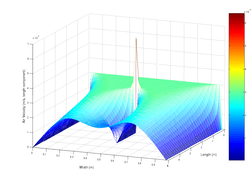ファイル:Navier Stokes Laminar.svg

この SVG ファイルのこの PNG プレビューのサイズ: 750 × 600 ピクセル. その他の解像度: 300 × 240 ピクセル | 600 × 480 ピクセル | 960 × 768 ピクセル | 1,280 × 1,024 ピクセル | 2,560 × 2,048 ピクセル | 900 × 720 ピクセル。
元のファイル (SVG ファイル、900 × 720 ピクセル、ファイルサイズ: 9.37メガバイト)
ファイルの履歴
過去の版のファイルを表示するには、その版の日時をクリックしてください。
| 日付と時刻 | サムネイル | 寸法 | 利用者 | コメント | |
|---|---|---|---|---|---|
| 現在の版 | 2016年3月15日 (火) 01:06 |  | 900 × 720 (9.37メガバイト) | Nicoguaro | Smaller version |
| 2016年3月15日 (火) 00:58 |  | 900 × 720 (11.08メガバイト) | Nicoguaro | Change the jet colormap, since it is recognized as a bad option, in general. Formatting, and pythonic code (and vectorized operations). | |
| 2014年11月6日 (木) 23:34 |  | 720 × 540 (14.23メガバイト) | IkamusumeFan | User created page with UploadWizard |
ファイルの使用状況
以下の 34 ページがこのファイルを使用しています:
- ソフィア・コワレフスカヤ
- テレンス・タオ
- ピーター・オルバー
- ポール・パンルヴェ
- ヴォルフガンク・ウォルター
- 代用電荷法
- 偏微分方程式
- 偏微分方程式の数値解法
- 加藤敏夫
- 可積分アルゴリズム
- 増田久弥
- 変数分離
- 差分法
- 常微分方程式
- 常微分方程式の数値解法
- 広田の方法
- 広田良吾
- 微分方程式
- 有限体積法
- 有限要素法
- 木村俊房
- 狙い撃ち法
- 確率微分方程式
- 神保道夫
- 積分因子
- 積分微分方程式
- 精度保証付き数値計算
- 線型微分方程式
- 藤田宏
- 複素微分方程式
- 計算機援用証明
- 非線形システム論
- Template:Differential equations
- Template:Differential equations/doc
グローバルなファイル使用状況
以下に挙げる他のウィキがこの画像を使っています:
- ar.wikipedia.org での使用状況
- ary.wikipedia.org での使用状況
- bcl.wikipedia.org での使用状況
- ca.wikipedia.org での使用状況
- Equació diferencial
- Anàlisi d'elements finits
- Plantilla:Equacions Diferencials
- Retrat de fase
- Mètode del volum finit
- Equació característica (càlcul)
- Equació diferencial homogènia
- Estabilitat de Liapunov
- Exponent de Liapunov
- Estabilitat exponencial
- Estabilitat estructural
- Teoria de les pertorbacions
- Teoria de la pertorbació (mecànica quàntica)
- Estabilitat marginal
- Recurrència lineal amb coeficients constants
- Principi màxim
- Principi de màxim de Hopf
- Mètodes numèrics per a equacions diferencials ordinàries
- cy.wikipedia.org での使用状況
- en.wikipedia.org での使用状況
- eu.wikipedia.org での使用状況
- hi.wikipedia.org での使用状況
- hy.wikipedia.org での使用状況
- id.wikipedia.org での使用状況
- ko.wikipedia.org での使用状況
- lfn.wikipedia.org での使用状況
- mk.wikipedia.org での使用状況
- ml.wikipedia.org での使用状況
- ms.wikipedia.org での使用状況
このファイルのグローバル使用状況を表示する。


 French
French Deutsch
Deutsch



